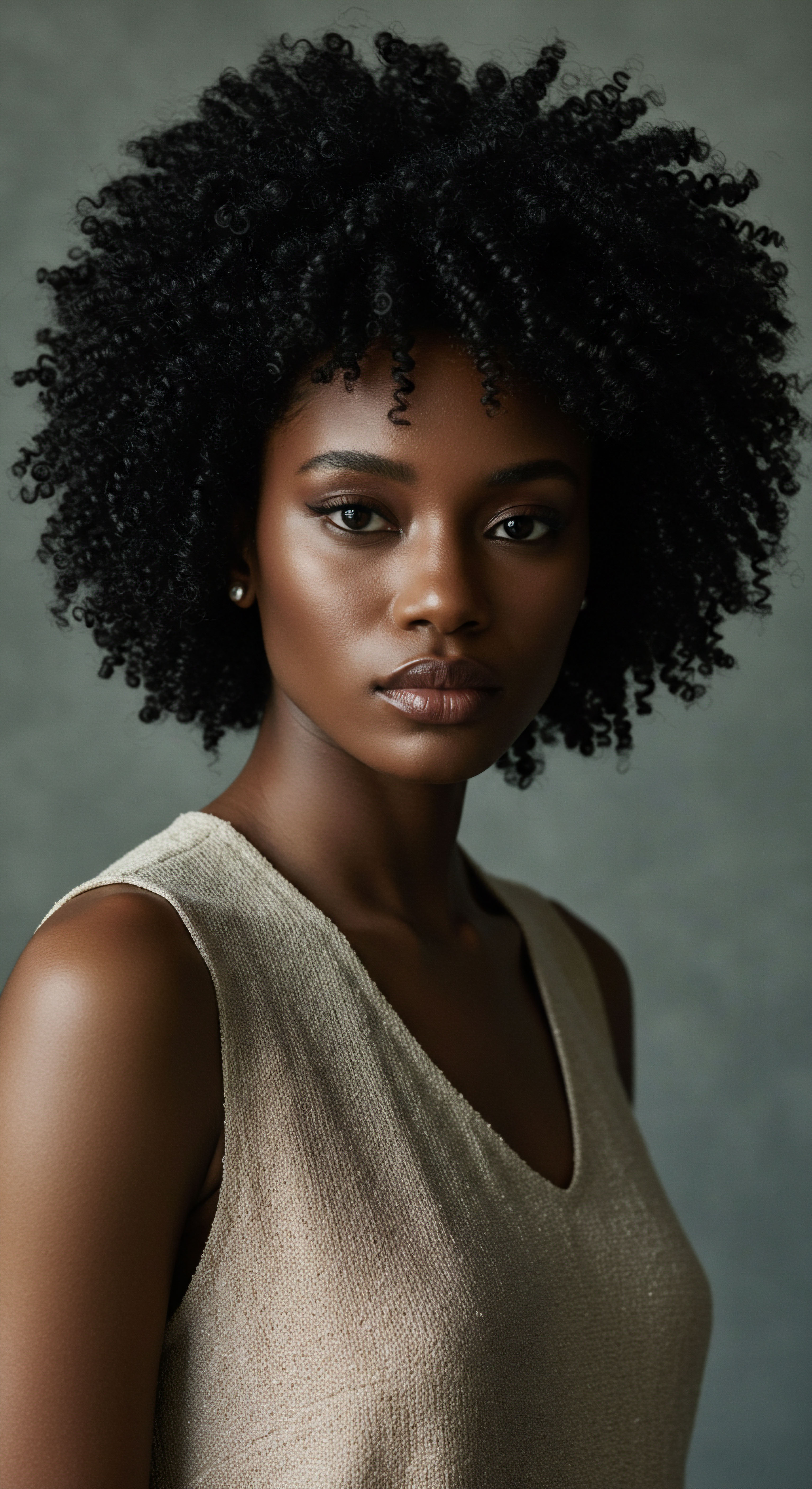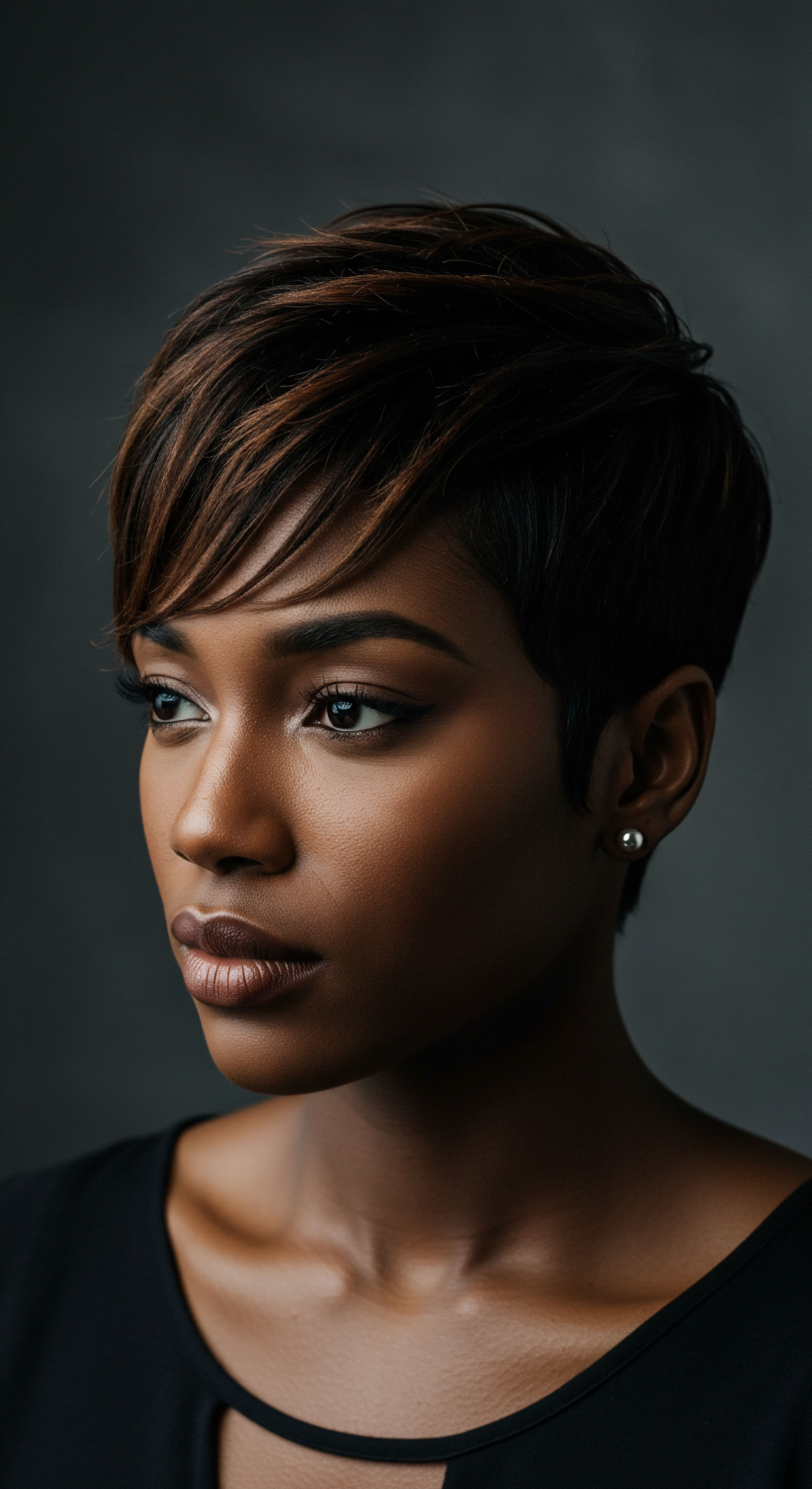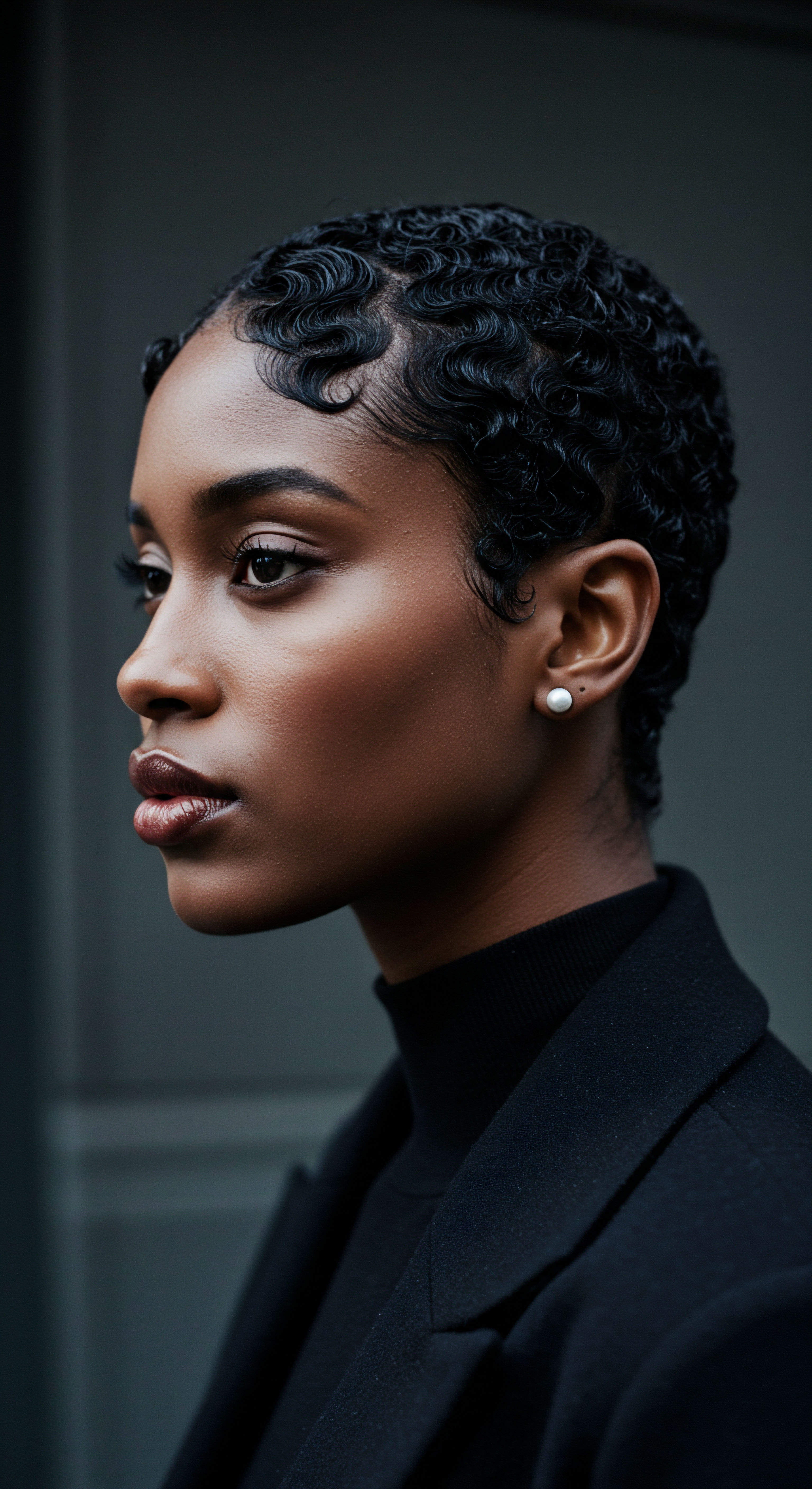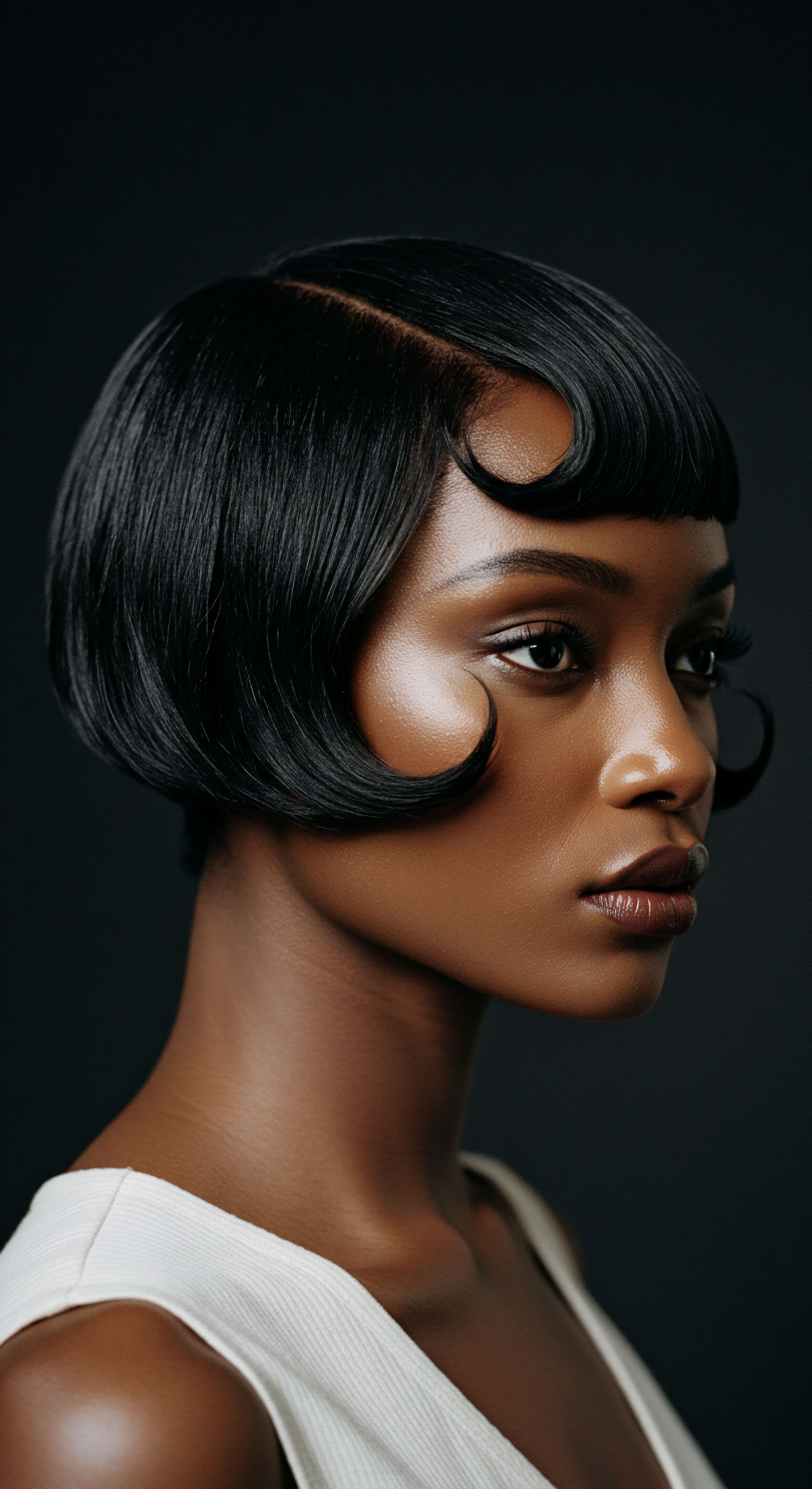
Roots
Consider the gentle hum of conversation, the rhythmic cadence of fingers at work, the shared laughter that echoes in a space where generations sit together. This intimate scene, far from a fleeting moment, once formed the bedrock of communal existence across ancient African societies. Hair care, often perceived through a modern lens as a solitary act of self-adornment, held a far deeper purpose in these historical contexts.
It was a language, a chronicle, a living canvas that spoke volumes about an individual’s journey and their place within the collective. The care given to hair, from the selection of natural oils and pigments to the sculpting of elaborate forms, extended beyond mere aesthetics; it represented a profound engagement with identity, status, and the spiritual realm.
The earliest archaeological findings suggest that Africans adorned their hair millennia ago, with evidence from ancient Egypt showcasing elaborate wigs and braids that signaled social standing and spiritual conviction. From the Kingdom of Kush to various West African cultures, hair served as an expression of power and social cohesion. The tools themselves, such as combs unearthed in Kemet (ancient Egypt) dating back over 6,000 years, illustrate a long-standing dedication to hair maintenance and styling. These combs, sometimes decorated with symbols reflecting respect for nature, underscore a sophisticated understanding of hair care that was intertwined with cultural beliefs.
Ancient African hair care was a communal practice, speaking to identity, status, and spiritual connections.
Beyond the practical aspects of cleanliness and protection, hair was often considered the most elevated part of the body, a conduit for spiritual energy, connecting individuals to their ancestors and the divine. This spiritual dimension elevated hair care from a mundane task to a sacred ritual, one that reinforced shared cosmologies and communal understanding. The very act of styling became a ceremony, a moment where beliefs were reaffirmed and cultural continuity was upheld.

What Did Hair Signify in Ancient African Communities?
Hair in ancient African societies functioned as a powerful communication system. It could convey a person’s age, marital status, occupation, religious affiliation, wealth, and social rank. Different ethnic groups, such as the Yoruba of Nigeria or the Himba tribe in Namibia, possessed unique styles that identified their tribal affiliation. For example, specific braiding patterns among the Yoruba could signify community roles, while the Himba coated their dreadlocked styles with red ochre paste, symbolizing their bond with the earth and their forebears.
This visual language was universally understood within communities, allowing for immediate recognition of an individual’s place and role. A woman’s hairstyle might signal her marital status, her readiness for marriage, or even her ability to bear healthy children. The complexity and adornment of a hairstyle often reflected an individual’s wealth or position, with gold, beads, and shells serving as markers of prosperity and social standing.
| Symbolic Aspect Age |
| Examples of Meaning Transition from childhood to adulthood, seniority. |
| Symbolic Aspect Marital Status |
| Examples of Meaning Single, married, widowed, or ready for marriage. |
| Symbolic Aspect Social Rank |
| Examples of Meaning Leadership, royalty, commoner status. |
| Symbolic Aspect Tribal Affiliation |
| Examples of Meaning Specific patterns identifying ethnic group. |
| Symbolic Aspect Spiritual Beliefs |
| Examples of Meaning Connection to ancestors or deities, protection. |
| Symbolic Aspect Hair provided a visual shorthand for an individual's place within their community. |
The importance of hair as a social determinant extended to every aspect of life, even influencing perceptions of mental or emotional well-being. In some Nigerian communities, hair that appeared undone could suggest depression, uncleanliness, or even mental distress. This communal gaze, while potentially burdensome, also served as a mechanism for social support, as it allowed community members to recognize when someone might be in need.

Ritual
The soft whisper of a comb gliding through textured strands, the gentle pull of a braid taking shape, the shared silence punctuated by moments of instruction and storytelling – these are the sensations that filled the air during ancient African hair care sessions. This was not a hurried task, but a deliberate, often lengthy process, sometimes spanning hours or even days, transforming it into a profound social occasion. The very act of styling hair became a space where practical wisdom intertwined with emotional connection, creating a shared experience that reinforced community bonds.
These sessions served as informal academies, places where knowledge of hair care techniques, cultural stories, and life lessons passed from one generation to the next. Mothers would sit with their daughters, aunts with their nieces, and friends with one another, sharing not only styling methods but also advice, gossip, and personal experiences. This oral transmission of history and tradition cemented familial and communal ties, ensuring that cultural heritage remained vibrant and alive.
Hair styling sessions served as informal academies, passing cultural knowledge and strengthening bonds.

How Did Shared Hair Care Practices Create Social Solidarity?
The communal nature of hair care fostered a strong sense of social solidarity. Individuals relied on one another for assistance with styles that were often complex and time-consuming. This reliance built trust and interdependence.
For many, the hair styling process was a physical manifestation of mutual support and care. The rhythm of braiding, the close physical proximity, and the extended time spent together created an environment ripe for open communication and emotional intimacy.
Beyond daily maintenance, specific hairstyles were central to rites of passage, marking critical transitions in an individual’s life. These could include ❉
- Adolescence ❉ Young girls might receive their first elaborate braids as a sign of their transition into womanhood, signifying a new social status.
- Marriage ❉ Brides often wore special, intricate hairstyles on their wedding day, symbolizing their new role and status within the community.
- Leadership ❉ Certain styles were reserved for those assuming positions of authority or entering specific age sets, as seen with Maasai warriors whose distinctive hairstyles marked their initiation.
- Mourning ❉ In some communities, hair might be shaved after the loss of a loved one, symbolizing a period of grief and renewal.
These communal rituals reinforced collective identity, educating younger generations about their future roles and preserving indigenous knowledge.

What was the Role of Tools and Adornments in Hair Care Rituals?
The tools and adornments used in ancient African hair care were not merely functional; they carried symbolic weight and often reflected the artistic prowess of the community. Combs, made from wood, bone, or ivory, were not just for detangling but could be status symbols, decorated with meaningful motifs. Archaeological discoveries from ancient Egypt and Kush reveal combs dating back thousands of years, some bearing intricate designs that demonstrate a reverence for nature and artistry.
Adornments such as beads, cowrie shells, and metallic elements were frequently incorporated into hairstyles. These additions often communicated wealth, marital status, or tribal identity. For instance, Fulani braids were (and still are) often adorned with beads and cowrie shells, symbolizing beauty, wealth, and cultural pride.
The choice and placement of these adornments could also signify specific rituals or ceremonies, such as weddings or coming-of-age practices. The presence of such detailed artistry speaks to the value placed on hair as a canvas for cultural expression and a repository of communal narratives.
| Adornment Beads |
| Potential Symbolism Wealth, status, beauty, protection, rites of passage. |
| Adornment Cowrie Shells |
| Potential Symbolism Fertility, prosperity, spiritual connection, wealth. |
| Adornment Metallic Accents |
| Potential Symbolism Status, royalty, tribal identity. |
| Adornment Ochre Paste |
| Potential Symbolism Connection to earth, ancestral ties (Himba tribe). |
| Adornment These elements added layers of meaning to styled hair. |

Relay
The very fibers of hair, when viewed through the lens of ancient African societies, cease to be mere biological structures; they become living archives, repositories of collective memory, and conduits for intergenerational wisdom. The intricate dance of hands styling hair was never simply about aesthetics; it was a deeply social, psychological, and sometimes even economic exchange that fortified the collective spirit. To truly grasp the ways hair care strengthened communal bonds, one must look beyond the visible styles and consider the profound, unseen currents of cultural transmission and social cohesion they facilitated.
Consider the profound social engineering inherent in these practices. Hair care sessions often extended for hours, sometimes days, requiring patience, skill, and mutual reliance. This extended period of close physical and emotional proximity fostered an environment where verbal and non-verbal communication flowed freely. Elders imparted wisdom, shared historical narratives, and offered guidance, while younger generations listened, learned, and contributed.
This consistent, hands-on transmission of cultural norms, values, and oral histories solidified collective identity and ensured continuity across time. It was a dynamic, living classroom where social etiquette, communal responsibilities, and ancestral stories were absorbed through direct participation.

How Did Hair Care Practices Transmit Cultural Knowledge and Values?
The process of hair styling served as a direct mechanism for the transmission of cultural knowledge and values. It was a space where practical skills, such as braiding techniques passed down through generations, were taught. Yet, the instruction went beyond the technical. As fingers worked through strands, stories of origin, myths, and the exploits of ancestors were recounted.
Moral lessons, proverbs, and riddles were shared, shaping the worldview of the younger participants. This form of embodied pedagogy meant that cultural education was not an abstract concept but a lived experience, directly tied to the physical act of beautification.
For instance, in the Maasai community, specific hair rituals marked age-set transitions, transmitting indigenous knowledge, legends, and life skills through songs and folktales. The Eunoto ceremony, where Maasai warriors ceremonially shaved their long hair, signified their transition to elderhood, a moment of profound social and moral instruction. This communal act of hair transformation, guided by mothers, solidified a young man’s new responsibilities and place within the societal hierarchy.
| Aspect Transmitted Technical Skills |
| Examples of Content Braiding patterns, styling techniques, product application. |
| Aspect Transmitted Oral Histories |
| Examples of Content Ancestral stories, tribal origins, significant events. |
| Aspect Transmitted Social Norms |
| Examples of Content Etiquette, respect for elders, community responsibilities. |
| Aspect Transmitted Spiritual Beliefs |
| Examples of Content Hair as a connection to the divine, messages to deities. |
| Aspect Transmitted These sessions were dynamic learning environments, ensuring cultural continuity. |

Could Hair Practices Be a Form of Social and Economic Currency?
Indeed, hair practices could possess a distinct form of social and economic currency. Skilled braiders, known as “onídìrí” among the Yoruba, held positions of respect within their communities. Their artistry was not merely aesthetic; it was a specialized trade, often passed down within families, contributing to the economic vitality of households and communities. The time and expertise invested in creating elaborate hairstyles represented a tangible value.
Consider the often-overlooked economic aspect during periods of extreme duress. During the transatlantic slave trade, when African people were forcibly displaced, hair practices became a hidden form of survival and resistance. Some enslaved African women, particularly rice farmers, braided rice seeds into their hair as a means of preserving both sustenance and cultural heritage. More strikingly, cornrows were reportedly used to create and transfer maps, guiding escape routes from plantations.
This incredible ingenuity highlights how hair care, stripped of its traditional communal context, was repurposed as a tool for collective survival and silent rebellion. This specific historical data point reveals a profound layer of resilience and resourcefulness, demonstrating how hair, beyond its aesthetic or social functions, became a critical instrument for collective liberation and the preservation of a people’s very existence against unimaginable oppression.
Hair care, beyond its beauty, served as a powerful medium for survival and resistance during enslavement.
This transformation of hair into a clandestine communication system speaks to the depth of its embeddedness in African communal life. The styles, once openly proclaiming identity and status, became coded messages, understood only by those within the community who held the key to their interpretation. This shared secret, held within the very appearance of individuals, strengthened bonds of solidarity and trust among those facing common adversity.

How Did Hair Styling Influence Psychological Cohesion and Identity?
The psychological impact of communal hair care on group cohesion cannot be overstated. The shared experience of being groomed, or grooming another, fosters a sense of belonging and mutual understanding. In ancient African societies, where individual identity was deeply intertwined with group identity, these practices reinforced the feeling of being a valued member of the collective. The care given to one’s hair, and the communal recognition of its significance, contributed to a strong sense of self-worth and collective pride.
The act of braiding or styling could be a form of showing affection and care, solidifying friendships and family bonds. Mothers expressing love and guidance through their hands on their daughters’ hair created lasting emotional connections. This reciprocal care cultivated empathy and reinforced the idea that individuals were not isolated but part of a supportive network. The visual uniformity or shared symbolism of certain hairstyles within a group could also create a powerful sense of unity, a visible declaration of shared heritage and purpose.
Furthermore, the cultural value placed on hair as a spiritual conduit meant that these practices also connected individuals to a broader spiritual community, encompassing ancestors and deities. This spiritual dimension provided a profound sense of meaning and continuity, reinforcing the idea that the community extended beyond the living to include those who had come before. The maintenance of specific styles, therefore, was not just about physical appearance but about maintaining a harmonious relationship with the spiritual world and upholding a sacred lineage.
- Physical Touch ❉ The prolonged, gentle physical contact during styling sessions fostered intimacy and trust.
- Shared Time ❉ Hours spent together created opportunities for deep conversation, storytelling, and mutual support.
- Visible Identity ❉ Shared styles or symbolic adornments provided a visual marker of belonging and group affiliation.
- Ritual Participation ❉ Engaging in rites of passage through hair transformations solidified one’s place and role within the community’s narrative.

Reflection
As we consider the ancient African landscape, where hands moved with intention through coils and curls, a profound truth emerges ❉ hair care was never a trivial pursuit. It was a quiet symphony of connection, a delicate yet resilient thread binding individuals to their lineage, their community, and the very cosmos. The styles sculpted were more than mere fashion; they were living narratives, whispered histories, and silent declarations of belonging. These practices remind us that true beauty often resides not in isolation, but in the shared rhythms of human connection, in the quiet strength found within collective identity, and in the enduring legacy passed from one generation to the next, strand by precious strand.

References
- Byrd, Ayana, and Tharps, Lori L. Hair Story ❉ Untangling the Roots of Black Hair in America. St. Martin’s Press, 2001.
- Chimbiri, Kandace. The Story of Afro Hair, 5,000 Years of History, Fashion and Styles. Scholastic, 2021.
- Dabiri, Emma. Twisted ❉ The Tangled History of Black Hair Culture. HarperCollins, 2019.
- Omotos, Adetutu. “The Significance of Hair in Ancient African Civilizations.” Journal of Pan African Studies, 2018.
- Sieber, Frank. Hair in African Art and Culture. Museum for African Art, 1999.
- Byerly, Ingrid Bianca. The Social Life of Hair ❉ African Hairdressing Past and Present. University of Pennsylvania Press, 2009.
- McIntosh, Peggy. White Privilege ❉ Unpacking the Invisible Knapsack. Peace and Freedom Magazine, 1989.